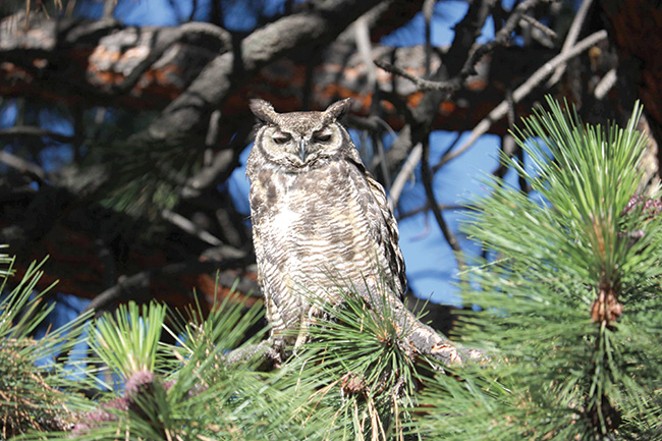It's early morning around 4 am. I'm parked along the edge of Tumalo Reservoir and standing outside my truck on this cold, December morning. The night sky's brilliance is amazing, but I'm here to listen for the deep hooting, territorial calls of Great horned owls instead of just enjoying the stars above.
These owls, named after their large ear tufts, can begin their courtship calling early in the season; hence my standing here in the cold and quiet. Fortunately, I don't have to wait long as I hear not one but two owls duetting from the woods across the reservoir. Their classic "Who's Awake? Me, too!" cadence and the hoot's deep pitch is unmistakable. I can also hear the pitch difference between the males' and females' hoots, the male being lower, so I'm assuming that this is a mating pair asserting their territorial claim. It's also the fifth pair of owls I've heard this morning since leaving my house off Knott Road, testimony to the early-season nesting of these owls.

"Great horned owls are common in Central Oregon and range from forested environments to backyards," said Lauri Turner, Deschutes National Forest wildlife biologist. There was even a pair that usurped a raven's nest in the front parking lot at the DNF's Supervisor's Office. "The ravens were not very happy about this and tried to haze the female from the nest until the male decided to roost in the next tree," said Turner. "We watched the ravens pull her tail feathers, remove sticks from the nest while she was on it, and heckle her constantly, but she remained unfazed." Though the Great horned successfully fledged young for three years in a row, the nest was blown out during a storm.
If those Great horned owls stay in the area, they'll have to wait for the ravens to build another nest, as the owls don't build their own. More likely, the owls will move on. And as Turner noted, perhaps the advantage to the owl's early season nesting is to utilize these raven or other raptor nests and become established prior to those birds showing up.
Predator-Prey Interactions
Great horned owls deserve the nickname "Flying tiger," as they are tenacious owls. Their large size and fierce nature make them apex predators, one that has few enemies besides humans. One nest cam set up at a nest in Savannah, Georgia, shows a red-tailed hawk knocking an owl off the nest, revealing a young owlet.
“One funny thing I’ve noticed during my time at Think Wild is that almost every great horned owl patient that we’ve gotten in has smelled like skunks.”—Molly Honea
tweet this
The camera also recorded an interesting variety of prey items delivered to the owlet by the adults including small mammals, bullfrogs, a barred owl, snakes, and even a great egret. Here in Central Oregon, squirrels, rabbits, and rodents are common prey items and, from olfactory observations by Think Wild staff: skunks.
"One funny thing I've noticed during my time at Think Wild is that almost every Great horned owl patient that we've gotten in has smelled like skunks," said Molly Honea, Think Wild development and communications coordinator. "Skunks are nocturnal, and the owls are going to eat what's out there." Though the smell doesn't affect the owls, Honea joked, "It does bother their rehabbers!"
Think Wild does see a variety of owl patients each year but Great horned owls are by far the most common.
"We have had 43 Great horned owls just this year," added Honea. "Owls in general tend to be pretty common at the hospital because they're active at night and get struck by cars." Surprisingly, the second-most-common reason Great horned owls are brought to the wildlife hospital is entanglement in barbed wire fencing. Both reasons also tend to be fatal due to the extent of the injuries sustained with a vehicle collision or entanglement with wire.
The extent of an owl's injuries will determine the course of action. Unfortunately, many injuries such as compound fractures or blindness in both eyes leads to the birds being humanely euthanized. Those with less severe injuries that make it through treatment and rehab have to pass live prey tests prior to being released back into the wild.
"People can sign up to be on our list and we'll reach out when there is a wildlife release," added Honea. "It's a cool way for people to engage with our program and support our work."
Record Keeping
I plan to upload my owl observations into eBird, an online birding database that tracks my sightings and connects me to the greater birding community. This list serve enables birders to contribute toward the science and conservation of wild avian species and to help spread the enjoyment of being out on cold winter mornings.







